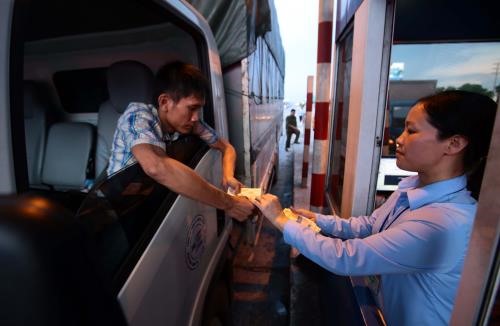 Society
Society

The Ministry of Transport has provided an explanation on the controversial toll collection policy on National Highway 5.
 |
| A driver uses small notes to pay tolls at the tollbooth No 1 on the National Highway 5 on December 11. — VNA/VNS Photo Phạm Kiên |
HÀ NỘI — The Ministry of Transport has provided an explanation on the controversial toll collection policy on National Highway 5.
Hundreds of drivers used bank notes in small amounts to pay toll at tollbooth No 1 on National Highway 5 earlier in December to protest against the booth.
The booth is one of the two tollbooths placed on the highway by the Việt Nam Infrastructure Development and Finance Investment Company (VIDIFI), which according to drivers was collecting tolls for the Hà Nội-Hải Phòng Expressway.
Explaining why drivers on National Highway 5 have to pay tolls for the expressway, Deputy Transport Minister Nguyễn Ngọc Long said that although it was intended to be built under the Build-Transfer-Operate (BOT) mechanism, the Hà Nội-Hải Phòng Expressway project is different from other BOT projects.
When deciding to build the expressway, due to lacks of funds, the State borrowed money from other sources to fund site clearance work instead of using money from the State budget, he said.
“The amount of toll that has been collected on National Highway 5 is to pay off the State’s debts back then,” he said.
"It was the decision of Prime Minister Nguyễn Tấn Dũng in 2007, and no legal documents at that moment forbade such a mechanism," he added.
Explaining the differences between the Hà Nội-Hải Phòng Expressway project and other BOT projects, Đào Văn Chiến, chairman of VIDIFI, project’s investor, said the project was in fact carried out under the Public-Private-Partnerships mechanism, not BOT. It is because the project’s investment capital was collected from local sources, international credit funds and other development projects (industrial parks and urban areas) that will be built near the expressway, he said.
Under the PPP mechanism, 23 per cent of the VNĐ45 trillion (US$1.98 billion) investment capital was supposed to be paid by the State budget, and another 16 per cent by the development projects, Chiến added. However, as the State was not able to provide the capital in cash, it allowed VIDIFI to collect toll on National Highway 5, he said.
“We collect toll on National Highway 5 to recover our investment on the Hà Nội-Hải Phòng Expressway and on the upgradation projects of National Highway 5 in the 2013-16 period,” Chiến said, adding that the last major overhaul of the highway took place 18 years ago, and its current condition requires more upgradation in the future.
He added that though under the contracts of the 2016-20 period, the State would contribute 39 per cent of investment capital of the project and another VNĐ4 trillion ($176 million) on site clearance, VIDIFI has not received the money.
The Hà Nội-Hải Phòng Expressway generated VNĐ1.2 trillion ($52.8 million) of revenue in 2016, according to Chiến. With loan interest of VNĐ2.8 trillion ($123 million), capital recovery from the project will be impossible without support from the State, he said.
The transport ministry last week proposed two scenarios to reduce tolls on National Highway 5. In the first scenario, public buses, non-business light trucks and vehicles with less than 12 seats belonging to those who live close to the stations will be free to pass, while vehicles of organisations located in the area will be subject to a 20 per cent discount. The second scenario involves a universal discount for all vehicles passing the station. — VNS